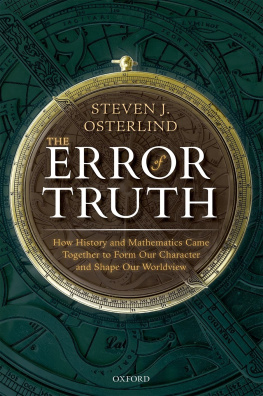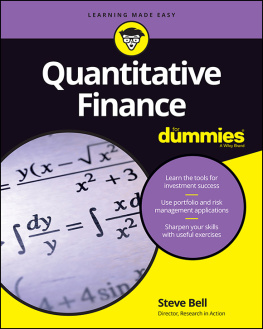The Error of Truth

Great Clarendon Street, Oxford, OX2 6DP, United Kingdom
Oxford University Press is a department of the University of Oxford. It furthers the Universitys objective of excellence in research, scholarship, and education by publishing worldwide. Oxford is a registered trade mark of Oxford University Press in the UK and in certain other countries
Steven J. Osterlind 2019
The moral rights of the author have been asserted
First Edition published in 2019
Impression: 1
All rights reserved. No part of this publication may be reproduced, stored in a retrieval system, or transmitted, in any form or by any means, without the prior permission in writing of Oxford University Press, or as expressly permitted by law, by licence or under terms agreed with the appropriate reprographics rights organization. Enquiries concerning reproduction outside the scope of the above should be sent to the Rights Department, Oxford University Press, at the address above
You must not circulate this work in any other form and you must impose this same condition on any acquirer
Published in the United States of America by Oxford University Press 198 Madison Avenue, New York, NY 10016, United States of America
British Library Cataloguing in Publication Data
Data available
Library of Congress Control Number: 2018956453
ISBN 9780198831600
ebook ISBN 9780192567390;
DOI: 10.1093/oso/9780198831600.001.0001
Printed and bound by CPI Group (UK) Ltd, Croydon, CR0 4YY
Links to third party websites are provided by Oxford in good faith and for information only. Oxford disclaims any responsibility for the materials contained in any third party website referenced in this work.
I dedicate this book to those who fill my life: my wife, Nancy, and our children
Alex, Janey, and Anna, and their families of Trent, Brody, Anderson, and Billy.
Acknowledgments
Although my name appears singly on the title page, I could not have written this book without the help of many people. I cannot thank each of them enough for providing valuable information, comments, and advice. Many of them patiently read drafts of chapters and offered extended critiques and reviews. Others offered a quick comment here and there to a question I posed. I am particularly indebted to those who read the manuscript in toto. To all, thank youespecially John Petrocik, Dan Knauss, Richard Robinson, Michel Belsky, and Ze Wang. A special thanks to my editor, Lynne Jensen Lampe, who corrected my composition and offered helpful suggestions during preparation of the work. Thank you, also, to Dan Taber, Oxford University Press editor for mathematics, statistics, and computing, as well as to the other reviewers from OUP. The book is much better because of your help. Any errors, misstatements, and omissions are my own.
Encouragement from family and friends was paramount, including from my wife, Nancy, and our children Alex, Janey, and Anna and their families of Trent, Brody, and Billy. Finally, special appreciation goes to our dear friends Glen and Marilyn Cameron, Ron and Deanna Walkenbach, and Dan and Rhonda Schoenleber. I know, too, that Phil and Sue are always there for me. It is a true blessing to have you in my life. Thank you, sincerely.
Contents
It is not knowledge, but the act of learning, not possession but the act of getting there, which grants the greatest enjoyment.
Carl Gauss (1808)
This is the story of a remarkable idea that has shaped humankind beyond the scope of any single historical event or clever invention. It recounts the astonishing and unexpected tale of how quantitative thinking was invented and rose to primacy in our lives in the nineteenth and early twentieth centuries, bringing us to an entirely new perspective on what we know about the world and how we know iteven on what we each think about ourselves: our very nature and identity. The widespread and lasting effect of thinking quantitatively is truly that profound.
Quantitative thinking, at its essence, is merely but mightily our inclination to view natural and everyday phenomena through a lens of measurable events: from anticipating the days weather, to feeling confident that medications will do their job, to sleeping soundly about investments, to being calm when boarding a plane, as well as thousands of routine and not-so-ordinary happenings in our lives. The uncertainty for all kinds of events, previously thought to be random, providential, or unknowable, is now vastly reduced because of our thinking quantitatively.
Quantification is the noun I use for quantitative thinking and its concomitant worldview. It implies a level of rational thought and decision-making that is forward-looking since outcomes can be anticipated with more certainty than ever before. Consequentlyand significantlywith quantification, we need not impulsively react after something has happened. No longer do we perceive ourselves as beings who are at the whim of fate or providence or who do things because Thats the way its always been, with a resigned Thats what happens. With this new viewpoint, we live with an internal sense of odds and probability. Quantification is our moment-by-moment reality.
There is a kind of freedom born from all the new choices available to us. It allows people to choose daily and long-term actions among alternatives, knowing the likelihood of a desired result. No longer is impulse or habit our only choice for action. From our quantitatively informed viewpoint, we can take meaningful, advantageous action beforehand. We react to events in new ways and interact with others differently. We are more attentive to predictive markers, as risk is gauged in our brains instantaneously. Uncertainty in outcome still exists, but now it is evaluated. We are more confident in our decisions, less doubtful.
Moreover, with quantification, we have even reformed our assessment of what we previously thought to be unbending fact. The new quantitative thinking has caused us to challenge the veracity of what was once believed to be factual, accurate, and faithful to observation. Everything we know changed because we see everything differently. That is, quantification altered our conception of reality and what is, for us, trueindeed, the Truth. The change in outlook brings an inconsistency or a kind of inaccuracy to our formerly known Truth. As a philosophical conceit, it is an error of Truth. We explore this thought in detail as we go along. In fact, this epistemological shift is interesting to trace.
The new viewpointsummarized as quantificationcame into being because of a momentous human achievement: namely, we learned how to measure uncertainty, a direct consequence of the invention and development of the science of probability. For the first time in history, using the methods of probability theory, we can anticipate an outcome for almost any event or phenomenon. For all kinds of things, we can describe odds and the likelihood of occurrence. By calculating correlational relationships, we understand much better how things go together.
Amazingly (yet seemingly now commonplace), with probability we can even make calculations for occurrences of events that have not yet happened: reliable predictions. For instance, we can track hurricanes and forecast their likely direction, anticipate longevity for patients with cancer, and expect particular sales outcomes based on how resources are allocated. Even planned military campaigns can be strategically evaluated in terms of their likelihood of success. Knowing the odds of an outcome is quite ordinary to us today, but it was not always so.





